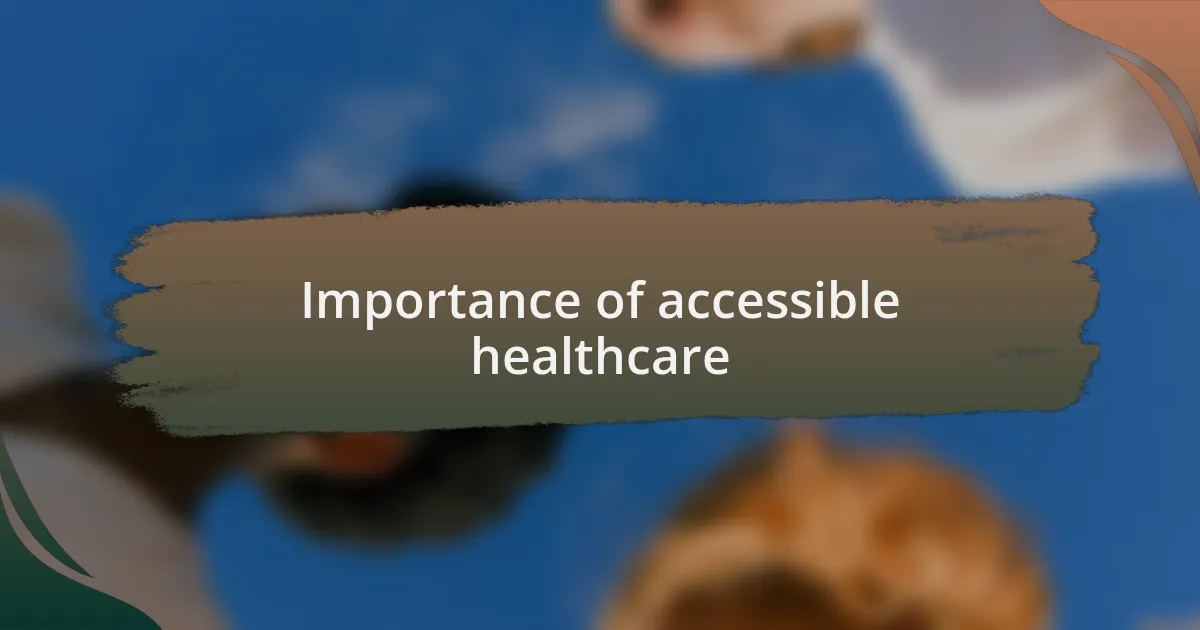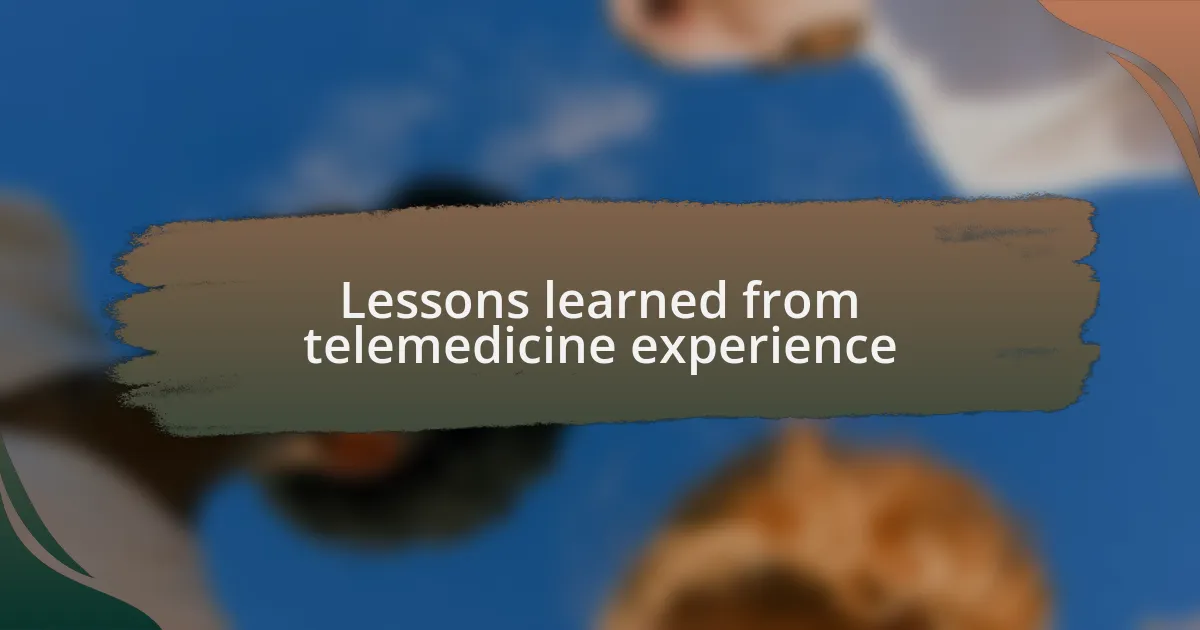Key takeaways:
- Telemedicine enhances accessibility to healthcare, particularly benefiting women in rural areas and those with busy lives.
- Women’s health advocacy is vital for addressing systemic barriers and improving healthcare outcomes for women.
- Challenges of telemedicine include connection issues, lack of physical examinations, and privacy concerns, impacting patient experience.
- Preparation and adaptability are key for effective telemedicine consultations, empowering patients to take control of their health.

Definition of telemedicine benefits
Telemedicine, at its core, brings healthcare into the comfort of your home, which can be a game-changer, especially for women juggling busy lives. I can recall a time when I faced a rather urgent health concern, and the convenience of connecting with a doctor online immediately eased my stress. Isn’t it empowering to know that with just a few clicks, expert advice is within reach?
One significant benefit of telemedicine is improved accessibility to healthcare services. I’ve seen friends who live in rural areas struggle to find specialists, but with telemedicine, they can consult a gynecologist or a mental health professional without the long commute. Doesn’t that open up a world of possibilities for those who need care but might face barriers?
Another advantage is the comfort factor; many women feel more at ease discussing sensitive health issues from home. I’ve shared personal experiences with friends who felt more candid during virtual appointments. Do you ever feel that a private setting influences how openly you communicate? It certainly rings true for me, highlighting the power of an environment in healthcare discussions.
Overview of women’s health advocacy
Women’s health advocacy is crucial in addressing the unique challenges women face in healthcare. I’ve often witnessed how collective voices have empowered women to demand better services, education, and rights regarding their health. Isn’t it inspiring to see communities come together for such a vital cause?
The movement isn’t just about raising awareness; it includes pushing for policy changes that improve women’s health outcomes. I remember attending a local forum where passionate advocates shared their stories, compelling us to consider issues like reproductive rights and access to preventative care. Listening to their experiences really opened my eyes to the systemic barriers many women confront daily.
At its heart, women’s health advocacy aims to create a world where every woman feels heard and respected in her health journey. I can’t help but reflect on my own encounters with healthcare systems, where feeling overlooked made me question if my issues were valid. When we advocate for women’s health collectively, we help ensure that no one feels alone in their struggles.

Importance of accessible healthcare
Accessible healthcare is essential for all, but it holds special significance for women. I recall a time when I needed immediate medical advice after experiencing troubling symptoms. The convenience of being able to consult a healthcare professional from home alleviated my anxiety, emphasizing how crucial access can be, especially for those juggling multiple responsibilities.
When healthcare is within reach, it fosters preventive measures and timely interventions. I remember feeling a wave of relief after my annual check-up became more manageable through virtual appointments. This not only saved time but also empowered me to prioritize my health without the added stress of logistics. Don’t you think everyone deserves that kind of accessibility?
Furthermore, the lack of accessible healthcare disproportionately affects marginalized groups. I’ve spoken with friends who have shared their struggles accessing basic services due to transportation barriers or lack of local facilities. Their stories highlight the pressing need for systems that ensure every woman, regardless of her circumstances, can access the care she deserves. Isn’t it disturbing that so many still face these challenges?

My telemedicine journey
My telemedicine journey began out of necessity. After a hectic week, I found myself dealing with a sudden flare-up of a chronic condition. Instead of the anxiety of driving to a clinic and waiting in a crowded office, I realized I could connect with my doctor through a simple video call. It felt like a weight lifted off my shoulders, knowing I could receive care without the additional stress.
Navigating my first telemedicine appointment brought its own set of emotions. As I settled into my living room, laptop in hand, I remember feeling a mix of excitement and apprehension. Would it be the same as an in-person visit? To my surprise, my doctor was just as attentive, and discussing my symptoms through the screen felt intimate. I often wonder, how many women miss out on this convenience due to a lack of awareness?
As I continued using telemedicine for follow-ups, I started appreciating the flexibility it provided. Instead of trying to fit appointments into my already packed schedule, I could choose times that worked best for me. It’s moments like these that make me realize how empowering accessible healthcare can be. Don’t you think that everyone should have the chance to experience that freedom?

Challenges faced during telemedicine visits
There were moments during my telemedicine visits that challenged my sense of connection. The first time my internet connection faltered mid-consultation, my heart raced in fear of losing vital communication with my doctor. I found myself wondering, how often do others experience similar frustrations that hinder effective care?
Another obstacle I faced was the lack of physical examination. Being unable to point to a specific area during my appointment made me feel somewhat isolated from the diagnostic process. I often pondered how much a doctor could truly understand a patient’s condition without that tactile feedback. This limitation forced me to adapt and articulate my symptoms in a way I hadn’t needed to before.
I also encountered the emotional weight of privacy concerns. While I appreciated the convenience, availing myself of care from my living room felt oddly vulnerable. I sometimes questioned whether my personal space would become too entangled with my healthcare experiences. Can we feel completely at ease discussing intimate health issues in what used to be a sanctuary? It’s a delicate balance that many women must navigate in this new era of healthcare.

Lessons learned from telemedicine experience
One important lesson I’ve learned is the value of preparation before a telemedicine appointment. I made it a habit to jot down my symptoms and questions ahead of time. This approach not only ensured I covered everything I wanted to discuss but also made me feel more in control of my healthcare, despite the distance separating me from my provider. Have you ever felt unprepared for an appointment? I certainly have, and it can make a big difference in the quality of care you receive.
Additionally, I’ve come to appreciate the adaptability that telemedicine requires. In one instance, I found myself explaining a symptom in detail because photos or written descriptions lacked the nuances a doctor could pick up in person. This experience highlighted a critical skill: being an advocate for my own health. I often ask myself, how can I communicate my needs more effectively? Embracing this challenge has empowered me to take an active role in my health management.
Lastly, the emotional landscape of telemedicine calls is unique. I recall a time when a simple video call with my doctor unexpectedly turned into a heartfelt conversation about mental well-being. This reminder that care goes beyond symptoms is essential; it’s about the whole person. I wonder, do we often overlook the emotional support we can receive in these digital spaces? I’ve learned that even in a virtual environment, connection is still possible.